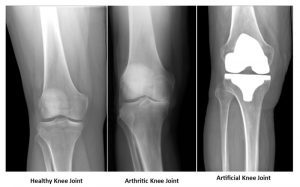
Various kinds of arthritis may affect the knee joint. To overcome this problem one may have to undergo a knee replacement surgery. It is known by another name called knee arthroplasty. This is a curative procedure to substitute the weight-bearing exteriors of the knee joint to ease the patient from pain and disability. This surgery is for people suffering from severe arthritis or a severe knee injury. There are two types:
- Partial Knee Replacement
- Total Knee Replacement
KNEE REPLACEMENT AND ITS TYPES
1. Partial Knee Replacement
Patients suffering from osteoarthritis undergoes this surgery which is an alternative to total knee replacement. This survey can be done when the damage is confined to a particular compartment of tube knee. Previously, this type of surgery was reserved for older patients with few activities.
Nowadays, many younger patients prefer their recovery to be quicker and less painful. In this replacement surgery, only the damaged part of the cartilage is replaced with a prosthesis.
Advantages of Partial Knee Replacement
This replacement surgery has some benefits and they are:
- Less bone and soft tissue dissection.
- Less blood loss.
- Fewer complications.
- Faster recovery of range of motion.
- Better range of motion overall.
Candidates for Partial Kneecap Replacement
The ideal patient for this replacement surgery is:
- Older than 60 years old.
- Less than 180 lbs.
- Less active.
- Has a good range of motion before surgery.
- Has minimal deformity
2. Total Knee Replacement
A patient requires this surgery when he or she has a severely damaged knee due to arthritis or injury. The patient may even begin to feel pain while sitting or lying down. The decision to have a total knee replacement surgery should be between you, your family, your family physician and your orthopedic surgeon.
During this surgery, the surgeon removes some bone and cartilage from the areas of the thigh bone and shin bone, where they may at your knee joint. Finally, the surgeon then replaces the 
Hence, this allows the knee joint smooth surfaces again so they can flex and bend more freely and painlessly. In many cases, the surgeon also substitutes the undersurface of the kneecap including a plastic coating.
Advantages of Total Knee Replacement
The advantages of this surgery are:
- Increases mobility.
- Decreases pain in patients who have an injured or arthritic knee joint.
Candidates for Total Knee Replacement
The ideal patient for this surgery is:
- Having pain and stiffness in the knee every day.
- Having trouble with daily activities like climbing stairs, dressing, bathing or preparing meals.
- The knee is unstable or ‘gives out’.
- Have a knee or leg deformity.
- Medications, weight loss has been tried but was not very helpful.
If medical treatments are not helping, this surgery may prove to be very effective. Nine out of 10 knee replacement patients experience immediate alleviation from knee pain, and 95% report they are satisfied with their procedure. About 90 percent of replacement kneecap joints persists for 10 years, while 80% is good for 20 and above years, depending on outpatient health and movement levels.
Most people who undergo this surgery are between the ages of 50 and 80. Also,t the average age is about 70. About 60 percent of the recipients are women. The procedure has a high success rate and is relatively safe and effective.
